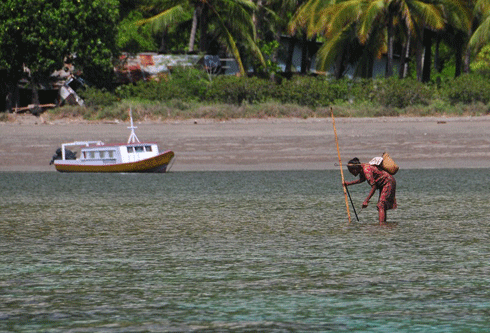
|
Published: 18 February 2013
Do environmental assessments protect the environment?
Are environmental impact assessments (EIAs) achieving what they were designed to achieve? Do they do a good job of protecting Australia’s diverse environments and their inhabitants for future generations? If not, what can be done to improve them?
Businesses protest against the cost and delay associated with EIAs. Green groups say they are not rigorous enough and that few projects are ever knocked back. Environmental consultants plead for more time, better funding and broader scope. The wider community clamours for its voice to be heard. And numerous experts criticise the short-termism and narrow focus of the EIA process. One thing all these groups agree on is that we need EIAs.1
At its broadest level, an EIA is a process for assessing environmental impacts likely to result from development proposals. It is primarily a scientific technique existing within a legal framework that focuses on ecological, biodiversity, social and economic impacts. For developers, miners and other project instigators, EIA represents a decision-making framework for modifying activity to reduce or eliminate the environmental impacts identified.
Angus Morrison-Saunders – Senior Lecturer in Environmental Assessment at Murdoch University – believes that in Australia, as a general rule, the EIA process gets it mostly right.
‘Conservationists will say the process doesn’t work because [environmental regulators] never reject anything, but in fact, the process does work, because it’s the assessment process that actually leads to changes to the project that make it acceptable,’ he says.
The perception is that EIAs are a one-off exercise, but Dr Morrison-Saunders says they are part of the ongoing process of adaptive environmental management.2 He and co-author John Bailey published a study in the journal Environmental Management in 1999 that reviewed the influence of EIAs on the course of six projects in WA – two water supply dams, an offshore oil and gas production facility, a mineral sands processing plant and a chemical manufacturing plant. The authors concluded that ‘a strong relationship exists between EIA and ongoing environmental management performance in WA’.
‘What normally happens is there’s a consultation process with stakeholders, government regulators, experts – that’s the assessment part – and they say, “if you did it this way it would be better, and if you reduce that bit of footprint that would be good, and if you change the mitigation here that would be fine”,’ commented Dr Morrison-Saunders.
‘You modify the development proposal until it becomes something that is acceptable to the majority of the players, and then you go ahead.’
Not everyone agrees. Environmental engineer Gavin Mudd from Monash University believes EIAs are failing to protect valuable natural resources, such as groundwater: particularly when it comes to coal seam gas development.
‘Some of the EIAs that I’ve looked at, the baseline groundwater studies are absolutely woeful,’ says Dr Mudd.
‘[This type of EIA] doesn’t have detailed groundwater quality information, it doesn’t have detailed aquifers, it doesn’t have detailed cross-sections, it doesn’t really review the water budget for that area – like how much recharge is coming in, and how much discharge is going out: from farmers, as well as from the coal mines in the area, as well as through natural processes.’
Dr Mudd argues that regulators are not asking enough of proponents (the private or public organisation or individual intending to implement a project or development proposal) in terms of EIA quality, partly because government has so much invested in seeing the projects go ahead.
‘Government and industry don’t want to admit there is a real conflict of interest in government issuing exploration licences and earning [the government] hundreds of millions of dollars, and then it turns around and says that it can independently assess the mine project,’ he says.
Andrew Macintosh – Associate Director of the Australian National University’s Centre for Climate Law and Policy – says EIAs are as much about public consultation as they are about improving environmental outcomes. On that question, he feels the EIA process also leaves a lot to be desired.
‘The problem is that public participation sounds nice in theory and a lot of people support it in theory, but in practice it isn’t working,’ Assoc. Prof. Macintosh says.
To begin with, the EIA reports, which are required to be made available for public comment before a decision is made on a project, are often inaccessible.
‘The public gets 30 days to make comment on an EIA that can be up to 5000 pages long, which is completely unrealistic,’ he says. ‘A lot of them are standardised documents, and they just basically fill in the gaps, so the reader is often faced with hundreds, sometimes thousands, of pages of gumpf.’
He suggests regulating the size of the documents and ensuring succinct and accessible summaries of the most important points of the report.
Ironically, despite the high word count of EIAs, they still neglect major areas. One of these is the area of social impact – something Richie Howitt from the Department of Environment and Geography at Macquarie University says is sorely lacking in many sustainability assessments.
Prof. Howitt gives the example of the EIAs done on a series of open-cut coal mines in the upper Hunter Valley in New South Wales.
‘When we looked at the sum total of that work, we had a pile of EIA reports, probably up to 1.5 metres high, and of all of that paper, less than 80 pages was addressing the social domain, and most of that was addressing issues of employment and economic development.’
According to Prof. Howitt, the assessments neglected to address a huge range of issues, such as the impact of rapid changes in housing prices and accessibility, the price of local goods and services, the impacts on social exclusion of local Aboriginal Australians, and the impacts on Aboriginal Australian culture in the area.
‘Even [taking] the narrow view that the environment is about non-human elements, that piecemeal approach is potentially catastrophic in periods of dramatic change.’
Prof. Howitt also says the environmental impact assessment process has a poor track record of follow-up after a project has gone ahead.
‘Once you’ve got a project approval, there’s a very poor history of going back and checking whether the impacts that were predicted have occurred or haven't occurred, and whether the impact management processes proposed have been adequate or need to be reviewed.
‘We might at best get a five-year review, but five years of social catastrophe is a generation in most Aboriginal communities – it’s a disaster.’
Part of the problem is that the experts contracted to undertake EIAs tend to be scientific experts on engineering, hydrology or ecology, for example, but not the social domain.
A whole industry has sprung up around EIAs, with consultants who specialise in these assessments. Assoc. Prof. Macintosh says there are some extremely competent experts in the industry, but they are hamstrung by a shortage of time and resources.
‘When people have actually looked at how accurate these assessments are, they have found a significant gap between the predicted impacts and actual impacts. The reports have predicted that x was going to happen, when in fact, the impact was y,’ he says.
‘When you think about it, the inaccuracy in predictions is not that startling. The contractors have to make assessments about difficult- to-predict variables with little information and compressed timeframes.
‘For example, species and ecological community assessments are often conducted from one site visit. If it’s a herbaceous species and you walk across the site and it’s not the right time of year, you aren’t going to see it.’
Another concern is the fact the consultants are paid by the proponents. ‘So you have that inherent problem everybody knows, particularly researchers, that when you get money from somebody it tends to influence what you say,’ says Assoc. Prof. Macintosh.
However, Dr Morrison-Saunders says a ‘user-pays’ system is the best way to go, as it places the responsibility on the proponents, rather than the consultant or regulator.
‘If you make the regulator responsible, they can prescribe all sorts of management measures that proponents have to do, which seems fine. But then what happens when the management measures are done exactly according to the book, and they don’t work?’ he asks.
‘If it’s the mining company who is responsible for the environmental performance and it’s the managing director of the mining company who could theoretically be jailed or fined $1 million if they have a pollution incident or they don’t do the right thing, then they have to employ appropriate consultants.’
While the current EIA process has come in for its fair share of criticism, Dr Morrison-Saunders believes it succeeds in striking a balance between competing interests.
‘There’s an art to impact assessments – and that’s the art of striking this balance between enough scientific information to make an informed decision and put in place a robust management system, and bowing to the pressures of politics and short-term economic gains.
‘What tends to happen is everyone grizzles and moans and the good things of the EIA process are quietly ignored: good things about how projects are redesigned or how public comments are taken on board and people’s concerns are actually woven into the redesigning projects or management in a different way.’
1 The international Convention on Biological Diversity (CBD) defines environmental impact assessment (EIA) as a tool used to identify prospective environmental, social and economic impacts of a project, prior to a regulator deciding whether or not to approve the project.
2 According to the CBD, although EIA legislation and practice vary around the world, the basic steps involve: screening projects to determine EIA applicability; scoping to identify which impacts are relevant to assess and to set terms of reference; identifying the likely environmental impacts of the project or development, and detailing alternatives; publishing the actual EIA report, which should include a non-technical summary for a general audience; review, assessment and approval (or not) of the project by the regulator, based on the EIA report; and monitoring, compliance, enforcement and environmental auditing.





